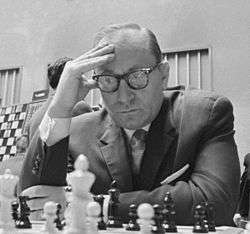László Szabó (chess player)
| László Szabó | |
|---|---|
|
Szabo in 1966 | |
| Full name | László Szabó |
| Country | Hungary |
| Born |
March 19, 1917 Budapest, Hungary |
| Died |
August 8, 1998 (aged 81) Budapest, Hungary |
| Title | Grandmaster |
| Peak rating | 2565 (January 1973) |
László Szabó ([ˈsɒboː ˈlaːsloː] March 19, 1917 – August 8, 1998) was a Hungarian grandmaster of chess.
Born in Budapest, he burst onto the international chess scene in 1935, at the age of 18, winning the first of Hungarian Championships, an international tournament in Tatatóváros, and was selected to represent his country at the 1935 Warsaw Olympiad. Onlookers at the Olympiad marvelled at the youngster's flair for attacking chess, a style that ran contrary to the dour, positional approach adopted by his countrymen. It is thought that the young Szabó studied under the tutelage of Géza Maróczy, then a patriarchal figure in Hungarian chess, having previously trained future world champions, Max Euwe and Vera Menchik.
Prior to World War II, there were other successes, including outright victory at Hastings 1938/39 (a tournament he was to hold a long association with). He began a career as a banker, dealing in Foreign Exchange.
Then, at the outbreak of war, Szabó was attached to a Forced Labour Unit and later captured by Russian troops who held him as a Prisoner of War. After the war, he returned to chess and played many major international events. He finished fifth at Groningen 1946, an extremely strong tournament which included Botvinnik, Euwe, Smyslov, Najdorf, Boleslavsky and Kotov. At the Saltsjöbaden Interzonal of 1948, he finished second to Bronstein and took outright first place at Hastings 1947/48, Budapest 1948 and Hastings 1949/50. A share of fifth place at both the Saltsjöbaden 1952 Interzonal and the Gothenburg Interzonal of 1955, meant that each of his Interzonal finishes had been strong enough to merit him a place in the corresponding Candidates Tournament. It was at his third and final Candidates, held in Amsterdam in 1956, that Szabó made his most promising bid for a World Championship title challenge. He tied for third place with Bronstein, Geller, Petrosian and Spassky, behind Smyslov and Keres.
Into the 1960s and 1970s, he continued to excel in international competition; first at Zagreb 1964, first at Budapest 1965 (with Polugaevsky and Taimanov), first at Sarajevo 1972, first at Hilversum 1973 (with Geller) and tied for first at Hastings 1973/74 (with Gennady Kuzmin, Timman and Tal).
In total, he represented Hungary at 11 Olympiads, playing first board on five occasions and delivering many medal-winning performances. In 1937, he took the team silver and individual silver medals, in 1952 an individual bronze, in 1956 a team bronze and in 1966, team bronze and individual silver.
Szabó was the best player in Hungary for nearly 20 years (eventually being succeeded by Lajos Portisch around 1963/64) and at the peak of his powers, one of the top 12 players in the world.
His family donated Szabó's entire chess library and his papers to the Cleveland Public Library John G. White Chess and Checkers Collection. The John G. White Collection of Chess and Checkers is the largest chess library in the world (32,568 volumes of books and serials, including 6,359 volumes of bound periodicals.)
References
- Hooper, David; Whyld, Kenneth (1992), The Oxford Companion to Chess (2 ed.), Oxford: Oxford University Press, pp. 405–406, ISBN 0-19-280049-3
- Crowther, Mark (21 September 1998), THE WEEK IN CHESS 202: Laszlo Szabo 19 March 1917 – 8 August 1998, London Chess Center
- OlimpBase – The History of the Chess Olympiads
Books
- Meine besten Partien (German, 248 pages, paperback, 1990.) (https://www.schachversand.de/e/listen/autoren/243.html)
- My best games of chess (English, 209 pages, hardback, 1986.) (https://www.schachversand.de/e/listen/autoren/V243.html)
External links
| Wikimedia Commons has media related to László Szabó. |
- László Szabó player profile and games at Chessgames.com
- Hungarian Chess Federation – Competitions
- Cleveland Public Library John G. White Chess and Checkers Collection
